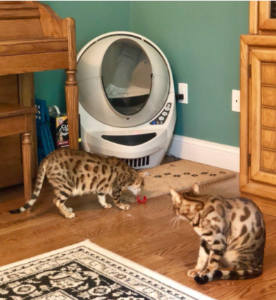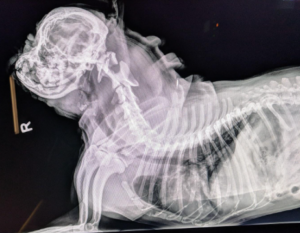Hello again friends of GVH! Thanks for sticking with my series on aging in companion animals. Here is the third and final installment with two more topics to cover. The first is changes in bathroom habits. Drinking more and urinating more can be symptoms of a lot of different illnesses – some as simple as a urinary tract infection, or they could be more serious like diabetes, kidney disease, or a bladder tumor. Kidney disease affects 30-50% of cats as they age, so if you notice more urine than usual in the litter box, it’s a good thing to get checked out – there are diet changes and other things that we can do to try to slow down the progression of the disease. Often to figure out what the issue is we will run a urinalysis and bloodwork to start, then see if an ultrasound of the bladder is necessary. My own senior dog Midnight was diagnosed with early kidney insufficiency this past spring based on urinalysis, bloodwork, and an ultrasound.

Nikola and Tesla actually love their futuristic litter box!
Straining to poop is another thing that can happen in older animals. Cats can get constipated – very constipated, sometimes to the point that we need to manually evacuate them, which makes nobody happy. Special diets that are high in fiber, stool softeners, and medications that help cats push stool out can be very useful for these old cats! Another thing that we can see is male dogs that are straining to defecate and producing flat or pencil-thin stool – this can be due to prostate enlargement. Hernias, anal gland issues, and arthritis can also cause problems with posturing to defecate, and getting in and out of the litter box.
The final topic that I wanted to cover is coughing and exercise intolerance. Exercise intolerance is not wanting to go on long walks anymore, or getting winded walking across the room or jumping onto the counter. Coughing can happen for a number of reasons – allergic bronchitis in dogs, asthma in cats, lung tumors, heart disease (often but not always accompanied by a heart murmur), collapsing trachea in little dogs, laryngeal paralysis in big dogs, heartworm disease…the list goes on. The best way to determine the cause and what we can do to help is usually a combination of listening to the heart and lungs with our stethoscopes, taking x-rays of the chest, and maybe doing some bloodwork. If a heart disease is suspected, there are some other tests that we can run to help us figure out what medications might be useful.

Hercules is a geriatric pug. Pugs are also brachycephalic, which you can see in this radiograph from the very short nose.
(Head is to the left, chest in the middle, and part of the abdomen on the right)
We’ve covered a lot of ground between these three posts! Overall, this is just a summary of some of the more common things that we see in aging pets. It is certainly not a comprehensive list. A lot of these changes can be slow, chronic changes that add up over time. We recommend bringing your geriatric cats and dogs in for exams more frequently; when we see them every 6-12 months, changes can sometimes be more obvious (especially when it comes to weight loss). However, you know your pet best – if your gut says something is off, we’re always happy to take a look!
As always, if your dog or cat shows any signs of coughing, sneezing, vomiting, diarrhea, straining, decreased energy or appetite, or changes in urination, please give us a call at 203-453-2707.
–Dr. Dana Muir
